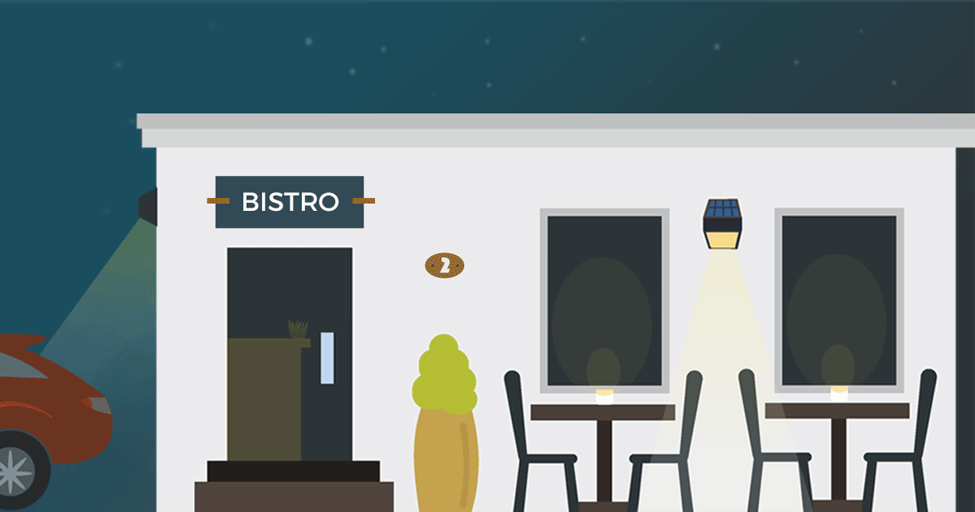Depending on the type of business, lighting can account for 20-50% of a business’s electricity consumption, according to the U.S Small Business Association. In other words, being sure your business has the most energy-efficient outdoor lighting possible is one way to potentially lower your energy consumption and manage your budget.
We’ve talked before about smart choices for indoor lighting and other small business cost-cutting measures. Now, we’re taking our energy-saving small business ideas outdoors as we discuss energy-saving outdoor lighting.
Because outdoor lights are left on for a long time, choosing energy-saving outdoor lighting is a smart way to look for business energy savings. Switching existing lights to CFLs or LEDs can help save energy. CFLs and LEDs are available as flood lights. Energy.gov says that many models have been tested to withstand the elements such as rain and snow, even if the bulbs are in exposed fixtures.
ENERGY STAR offers a number of energy-saving outdoor lighting options, as well. ENERGY STAR-certified fixtures are those that meet certain federal government criteria for energy efficiency. Many of ENERGY STAR’s energy-efficient outdoor lighting choices include automatic daylight shutoff and motion sensors, which further enable you to control the length of time lights are on and, therefore, the amount of energy that’s consumed.
High-Intensity Discharge (HID) lighting systems, which are primarily used for large areas, are another consideration when choosing outdoor lighting. HID outdoor lighting is most often found in garages, warehouses, and safety and security lighting. Older versions that still have mercury vapor lamps, the SBA notes, often do not qualify as energy-saving outdoor lighting. Systems that predate 1978 may also contain harmful substances such as PCBs, according to the SBA. In addition to replacing antiquated HID lighting, the SBA suggests reducing the wattage of existing HID lamps can also help improve your business’ energy-saving outdoor lighting. A special 360-watt metal halide lamp, for instance, can replace a 400-watt metal halide lamp without any substantive reduction in visibility. Before installing outdoor lighting changes, the SBA recommends talking to a lighting professional about your company’s specific needs.
Choosing outdoor lighting
Choosing energy-efficient outdoor lighting can have a potential environmental upside as well. The International Dark-Sky Association, a nonprofit concerned with light pollution, offers these tips when considering your outdoor lighting needs. Following them potentially could help reduce your business’ energy consumption as well as reduce unnecessary glare and skyglow (brightness in the night sky in build-up areas as a result of light pollution).
- Don’t light an area if it’s not needed.
- Turn off lights when not in use.
- Don’t use excessive amounts of illumination.
- Use timers, dimmers and motion sensors whenever possible.
- Use “full cut-off” or “fully shielded” lighting fixtures. That means no light should show above the 90-degree angle. Fully shielded lighting can be retrofitted.
- Use lighting sources with correlated color temperatures (CCT) of no higher than 3000K. Most products provide this information on the package.
How to choose solar lights
Increasingly, small business owners are considering outdoor solar LED lights when thinking about landscape lighting options. Outdoor solar lights are often easy to install and require little maintenance. Pathway lights and security lights as well as freestanding lamp posts are popular spots for the best outdoor solar lights.
The potential reduction in electricity costs from installing outdoor solar lighting can be significant. Outdoor solar lights use solar cells to convert sunlight into electricity. That electricity is then stored in batteries for use at night.
To find the best outdoor solar lights, you need to remember that siting is critical to success. You can have the best outdoor solar lights in the marketplace, but if they’re not placed in an area that receives the required amount of sun, they won’t work successfully. No matter which solar light cells you choose for your lighting should receive the manufacturer’s recommended hours of sunlight.
Energy.gov recommends looking for the “nightly run time” listing on any outdoor solar lighting system you’re considering for your small business. Nightly run times can vary depending on how clear the sky is and also the season, which Energy.gov notes matters, too. Operating times in the winter, for instance, can vary as much as 30-50% if an outdoor solar lighting system is not sized correctly for winter operation.
Installing outdoor lighting in the right spot is critical when considering the effectiveness of even the best outdoor solar lights. Inappropriate landscape lighting options, such as placing the lights near trees or buildings that shade the lights from the sun, can affect the solar lights’ performance. Energy.gov warns about bird droppings as well.
When considering how to choose solar lights, keep in mind that the best outdoor solar lights come in several forms. Some are self-contained units. Just put those in a sufficiently sunny spot and you’re good to go. For others, the lights are separate from the solar cell panel. In that instance, it is the panel that must be in the sunny location, not the light itself. The final Energy.gov note on the best outdoor solar lighting is to be sure to check that replacement bulbs or batteries are available with whatever system you want; some units do not have replacement options, which could be a costly mistake down the road.
Bottom line: Choosing the right outdoor lighting can make a difference in your small business’ energy costs.
